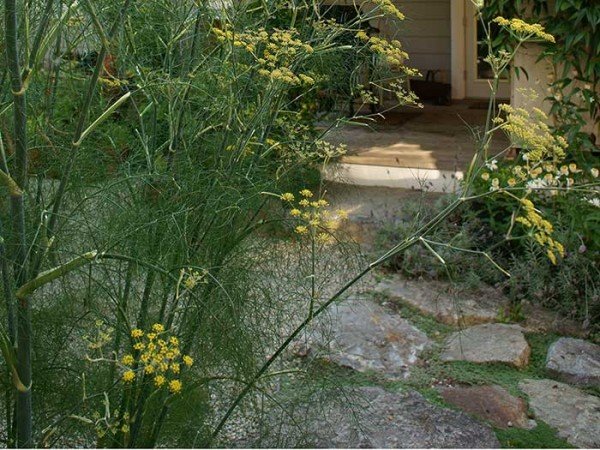
There are many ways to enjoy your edible garden in winter. Along with what’s still growing outdoors and indoors, such as my microgreens, I have cured squash, onions and garlic in my cold room; tomatoes, tomatillos, blanched zucchini, pesto and veggie soup in the freezer; and air-dried herbs hanging on hooks. And filling several decorative glass bottles are tasty, healthy, organic edible seeds from three prolific plants — bronze fennel, cilantro and lovage.
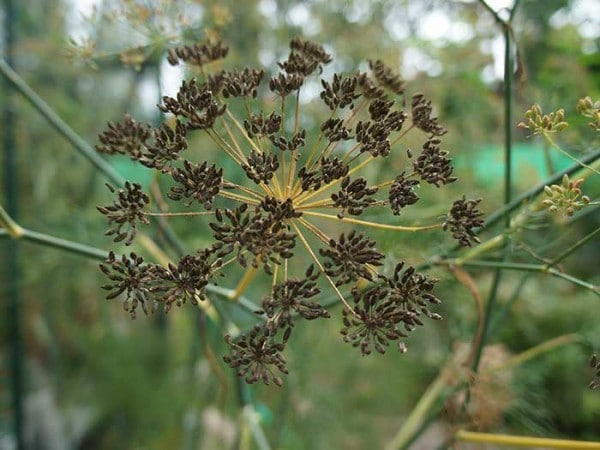
Bronze fennel
While each year’s food garden has both its dynamic and dodgy moments, there is invariably a particular high spot July through September when bronze fennel (the herb Foeniculum vulgare ‘Purpureum’) blazes upward, a mass of ferny garden architecture, culminating in mustard-yellow crowns of blossoms followed by star-like webs of green and yellow seeds. This self-seeding perennial has found its way into dusty, deer-trodden corners of my yard where previously nothing dared to grow, surviving periods of sustained drought despite never being watered.
In fact, bronze fennel is so hardy and prolific that it can be a bit of a problem in some gardens, and can even be considered invasive down south. With regard to my Pacific northwest garden, though, my response to concerns about any over-zealousness is similar to what I say about parsley, kale and other eager edibles: If it’s overrunning your garden, you’re just not eating enough of it!
Planting and growing bronze fennel
Sow seeds or tuck in seedlings in spring after frost has passed. Give it space — this statuesque beauty will grow to seven feet (2 m) tall and looks wonderful wherever you want a focal point in your garden. You can also allow a mature plant to self-seed in a barren area of the garden — just don’t let it get carried away. Bronze fennel thrives in sun, but can tolerate partial shade. It also needs good drainage and is drought tolerant due to its long taproot. This herb returns every spring after dying back for the winter. Cut it down in the fall to harvest the seeds and foliage—but leave a few of the hollow stems partially intact for beneficial insects to hibernate in.
How to eat bronze fennel
Magnesium-rich, digestion-enhancing fennel has been used for centuries to improve human well-being. Bronze fennel’s foliage, flowers and seeds are all useful in the kitchen. In late fall, when the seeds have mostly turned brown, snip the fennel stems and place them upside down in paper shopping bags. Come winter when the seeds are dry, gently thresh the seeds into a bowl and bottle them for culinary use. Foliage can be air-dried or chopped finely and frozen in ice cubes.
Seeds
- Steep fennel foliage or a teaspoon of seeds in boiled water for a soothing licorice-laced, digestion-enhancing tea.
- Strew seeds over bread dough before baking.
- Add seeds, foliage or even some of the fennel stalk to fish stock.
- Add seeds and chopped foliage to salmon or crab cakes. Decorate with pretty yellow fennel flowers.
- Sauté seeds with slices of turkey sausage to add to a tomato-based pasta sauce.
- Add seeds to sweets—blackberry quinoa cobbler or almond fennel-seed biscotti sound good?
- Chew undeveloped (green) or mature brown fennel seeds for an effective breath-freshening digestion booster.
Save these ideas for next season’s fennel foliage
- Top any seafood, particularly shrimp or spot prawns, with finely chopped foliage.
- Infuse oil with foliage for a licorice-flavoured gourmet drizzle.
- Use a mortar and pestle or a food processor to chop fennel foliage with oil, salt and garlic into a pesto, and slather it over seafood or vegetables.
- Sprinkle finely chopped foliage over summer cucumber salads.
- Wrap salmon or any other seafood in foliage before steaming or baking.
- Add finely chopped foliage to egg dishes and potato or green salads.
- Sprinkle finely chopped foliage over roasting potatoes or vegetables, then top with a few fennel seeds.
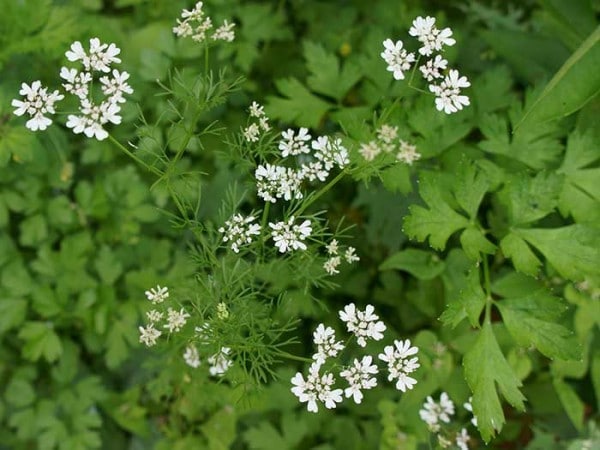
Cilantro/coriander
The cilantro/coriander plant (Coriandrum sativum) provides us with two harvests — the greens we call cilantro and savoury seeds we call coriander. A powerful natural body cleanser that binds to toxic metals within our systems and helps to flush them out, this annual herb is worthy of superstar billing. Plus, its spicy white flowers attract beneficial insects to our gardens and support bees.
Planting and growing cilantro
Cilantro does best summer through fall, so tuck in seeds July through early September. It doesn’t respond well to being transplanted, so direct-sow into a pot or (ideally) your garden soil. Snip away at your plants for tasty additions to salads and stir fries, but leave some plants to flower and set seed. Gather the mature brown seed as you see it; seed you don’t harvest will likely sprout prolifically. Cilantro can tolerate some partial shade, but basically needs a bright spot and rich, moist but well-drained soil.
How to eat coriander and cilantro
When collecting seeds, snip the seed heads into a paper bag. When they dry, gently thresh them into a bowl. Bottled and kept in a dry and cool place, coriander seed lasts for years. They’re best freshly ground, either with a mortar and pestle or in a clean coffee grinder. In addition to the little round seeds (coriander), cilantro’s leaves, flowers and roots are all delicious. Puree and freeze the plant as pesto if you can’t eat it fast enough while fresh.
Seeds
- Drink coriander-seed tea — it sweetens the breath.
- Add a spoonful of crushed coriander seed to the fruit in any crisp or cobbler.
- Use coriander seed in homemade curry powder.
- Marinate raw mushrooms in olive oil with lots of coriander seed, orange zest and a little balsamic vinegar.
- Toss sliced cauliflower with crushed coriander seed, olive oil, salt, pepper and orange zest—squeeze orange juice over top. Roast at 425°F until browned, turning cauliflower slices a couple of times. Garnish with cilantro leaves.
- Make coriander vinegar. Add a handful of lightly crushed seeds to light-coloured vinegar, strain after two weeks, and sprinkle over apple and celery or Waldorf-type salads.
Save these ideas for next season’s cilantro foliage
- Make cilantro butter by blending butter and minced cilantro leaves, or whirl them together in a food processor. Garnish butter with tiny cilantro florets and chopped leaves.
- Pulse a few cilantro leaves in your blender once or twice and add to tomatoes, peaches, nectarines or strawberries for fruit salsa. Add minced jalapeno and chopped sweet onions or scallions.
- Drizzle olive oil and chopped cilantro over sliced tomatoes.
- Fry cubes of potatoes with garlic, and garnish with a few handfuls of chopped cilantro.
- Use lots of chopped cilantro leaves in cabbage slaw. Add orange juice to the vinaigrette.
- Garnish tomato soup or roasted red pepper soup with chopped cilantro.
- Mix thinly sliced cucumbers with cilantro, chives and yogurt—serve with curries.
- Make cilantro pesto using oil, peanuts, garlic, salt and pepper. Serve on rice or over Asian noodles, or make salad rolls stuffed with shredded veggies and cilantro pesto.
- Use cilantro flowers as a garnish on salads.
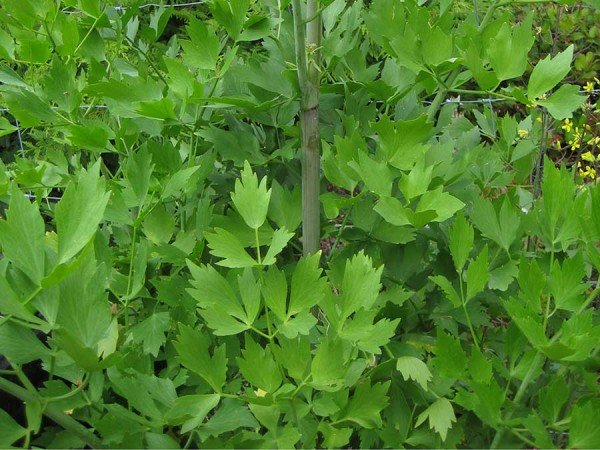
Lovage
Giant lovage (Levisticum officinale) deserves a place in every garden. Edible from root to leaves to its umbels of seeds, this seven-foot (2-m) perennial herb tastes like celery and is a fabulous befriender of beneficial insects that flock to its giant cartwheels of greenish-yellow flowers.
Planting and growing lovage
Sow seeds or tuck in a couple seedlings in the springtime after frost has passed.
Lovage returns every spring after dying back for the winter. Cut it down in the fall to harvest the seeds and leaves, but let some of the hollow stems remain intact to provide hibernation spots for beneficial insects. Lovage is deer resistant and thrives in partial shade. It needs rich, well-drained soil and is drought tolerant due to its long taproot, although it will droop if growing conditions become too dry. It grows easily from seed and self-seeds prolifically.
How to eat lovage
Like fennel, lovage is an excellent booster of digestion. The seeds and leaves bring the taste of celery to the kitchen—use sparingly because it is strongly aromatic. In late fall, when the seeds have mostly turned brown, snip them into a paper bag. However, allow a few of the seed-laden stems to remain standing in the garden through winter for feathered friends. When the seeds are dry, gently thresh them into a bowl and bottle for culinary use. Foliage can be air-dried or chopped finely and frozen in ice cubes.
Seeds
- Grind lovage seeds with salt or substitute a pinch of lovage for salt.
- Add seeds to pickles and nasturtium capers.
- Seeds are excellent in breads and crackers.
- Sprinkle seeds onto roasting fish, free-range chicken or squash.
- Seeds add flavour to soups, stuffings, lentils and other savoury dishes.
To use fresh foliage
- Add chopped lovage leaves to shepherd’s pie, salsa, turkey stuffing and rice.
- Spiff up vegetable soups with a couple of chopped lovage leaves.
- Make lovage vinegar. Harvest, wash and dry leaves. Pack loosely into clean jars. Cover with white wine vinegar, seal and store in the dark for a few weeks. Strain out solids before using. Try with rice or cider vinegar, too.
- Use hollow stems of lovage as straws to drink or stir mixed drinks like Caesars — anything that uses vegetable juice. Make sure there are no overwintering insects hiding in the stem before you sip!
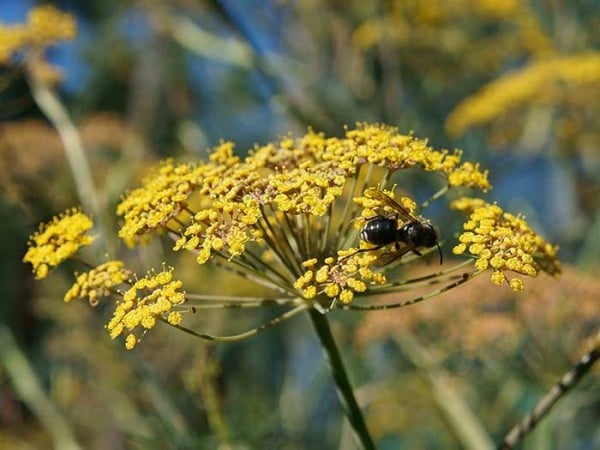
Pollinators that love fennel, lovage and cilantro
The anise swallowtail butterfly is strongly attracted to the members of the Apiaceae plant family, including fennel, lovage and cilantro. If you want to support butterflies, grow these plants, and you’ll find the green, yellow and black caterpillars of the butterfly chomping down the lacy foliage. Once they move on, the plants will spring back quickly wherever they might look a bit depleted.
Bees, too, are attracted to these herbs and will flock to their flowers. Other beneficial bugs that stop by for nectar are syrphid flies (hover flies) and lacewings, both of which help control aphids, as well as tachinid flies, which can help keep the cabbage butterfly in check (take note, kale growers). Ladybugs also can be seen in all life stages from egg to larvae to adult on the leaves of these plants, particularly lovage, which in my garden seems to serve as an incubator for the alligator-lookalike larvae that eventually develop into the cute little ladybugs that help keep my kale and other leafy greens safe from those insatiable aphids.
One quick cautionary note: Before you grab some seeds or chop a chunk of foliage from your fennel, cilantro or lovage, look closely to ensure that the seeds or foliage aren’t hosting beneficial insects. You don’t want to harm the very insects you’ve been trying to attract.
